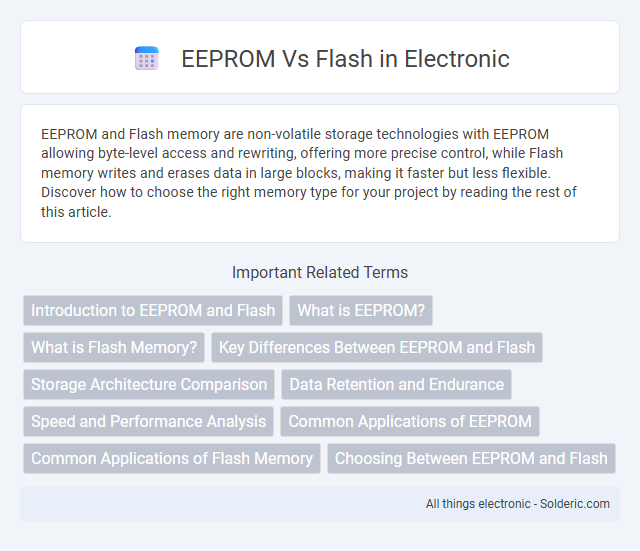EEPROM and Flash memory are non-volatile storage technologies with EEPROM allowing byte-level access and rewriting, offering more precise control, while Flash memory writes and erases data in large blocks, making it faster but less flexible. Discover how to choose the right memory type for your project by reading the rest of this article.
Comparison Table
| Feature | EEPROM | Flash |
|---|---|---|
| Memory Type | Electrically Erasable Programmable Read-Only Memory | Flash Memory (NAND or NOR) |
| Erase Method | Byte or Word Erase | Block or Sector Erase |
| Write/Erase Speed | Slower (milliseconds) | Faster (microseconds to milliseconds) |
| Endurance (Write Cycles) | 100,000 to 1,000,000 cycles | 10,000 to 100,000 cycles |
| Density | Low (kilobytes range) | High (megabytes to gigabytes) |
| Cost | Higher cost per byte | Lower cost per byte |
| Typical Use | Storing small amounts of data, configuration data | Mass storage, firmware, large data storage |
| Data Retention | 10 to 20 years | 10 years or more |
Introduction to EEPROM and Flash
EEPROM (Electrically Erasable Programmable Read-Only Memory) and Flash memory are non-volatile storage technologies used to retain data without power. EEPROM offers byte-level erase and write capabilities, making it ideal for small data storage and frequent updates. Flash memory, designed for block-level erasure and larger storage capacities, is commonly used in applications requiring fast read/write speeds and bulk data retention.
What is EEPROM?
EEPROM (Electrically Erasable Programmable Read-Only Memory) is a type of non-volatile memory that allows data to be electrically erased and reprogrammed at the byte level. Unlike Flash memory, which erases data in large blocks, EEPROM provides fine-grained control and is ideal for storing small amounts of data that require frequent updates, such as configuration settings and calibration parameters. Its endurance typically reaches up to 1 million write/erase cycles, making it suitable for embedded systems and microcontroller applications.
What is Flash Memory?
Flash memory is a type of non-volatile storage that retains data without power, commonly used in USB drives, SSDs, and memory cards. It allows block-level erasing and writing, making it faster and more efficient for large data storage compared to EEPROM, which erases and writes data byte-by-byte. Your devices benefit from Flash memory's high density and durability, enabling compact, long-lasting storage solutions.
Key Differences Between EEPROM and Flash
EEPROM and Flash memory differ primarily in their erase mechanisms and granularity; EEPROM allows byte-level erasure and rewriting, making it ideal for small data updates, while Flash erases data in larger blocks or sectors, leading to faster write times for substantial data. Flash memory typically offers higher storage densities and faster access speeds compared to EEPROM, which is often used for configurations and calibration data due to its endurance and precision. Understanding these differences helps you choose the most efficient memory type for your application's data storage and retrieval needs.
Storage Architecture Comparison
EEPROM utilizes a byte-level storage architecture allowing individual bytes to be electrically erased and reprogrammed, offering fine-grained data modification. Flash memory employs a block-level architecture, where data is erased and written in large blocks or sectors, enhancing speed and density but reducing flexibility for small data updates. The architectural difference impacts endurance, with EEPROM typically supporting higher write-erase cycles compared to Flash, making each suitable for distinct application requirements.
Data Retention and Endurance
EEPROM typically offers data retention of up to 20 years and endurance of around 1 million write/erase cycles, making it ideal for applications requiring frequent, small data updates. Flash memory provides data retention of about 10 years with endurance ranging from 10,000 to 100,000 write/erase cycles, suited for bulk storage and less frequent write operations. The trade-off between EEPROM and Flash lies in balancing endurance and capacity, where EEPROM excels in longevity and write cycles, while Flash offers higher storage density at lower cost.
Speed and Performance Analysis
EEPROM typically offers slower write speeds compared to Flash memory, making Flash more suitable for applications requiring rapid data storage and frequent updates. Flash memory's higher density and faster erase/write cycles significantly enhance overall system performance, especially in embedded systems and data logging. Understanding these speed differences helps you select the optimal memory type for your performance-critical projects.
Common Applications of EEPROM
EEPROM is commonly used in applications that require frequent small data updates, such as storing configuration settings, calibration data, and device identification information in embedded systems. Its ability to electrically erase and reprogram individual bytes makes it ideal for non-volatile memory storage in microcontrollers, smart cards, and automotive control units. Your devices benefit from EEPROM's endurance and precise data retention in environments where data integrity and reliability are critical.
Common Applications of Flash Memory
Flash memory is widely used in consumer electronics such as smartphones, USB drives, and solid-state drives (SSDs) due to its fast read/write speeds and high storage density. It is commonly employed in embedded systems for firmware storage, enabling quick updates and reliable performance. Your devices benefit from flash memory's durability and cost-effectiveness in applications requiring frequent data access and large storage capacity.
Choosing Between EEPROM and Flash
EEPROM offers precise byte-level data storage ideal for small, frequent write operations, while Flash memory provides larger capacity and faster erase/write cycles suitable for bulk data storage. Choosing between EEPROM and Flash depends on application requirements such as write frequency, storage size, and power consumption. Embedded systems with frequent updates favor EEPROM, whereas firmware storage and larger data sets benefit from Flash memory.
EEPROM vs Flash Infographic

 solderic.com
solderic.com